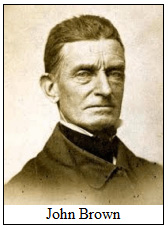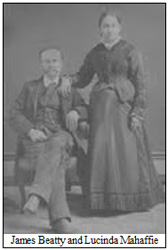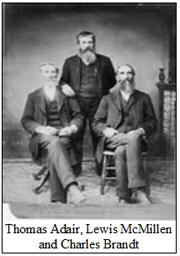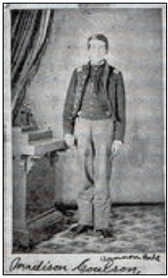
Volume 26, No.
5 – May 2013
Volume 26, No. 5
Editor: Stephen L. Seftenberg
Website:
www.CivilWarRoundTablePalmBeach.org
President's Message
Please remember that the Round Table will continue to
meet in the Mural Room at the Scottish Rite Hall in Lake Worth, 2000
North D Street, Lake Worth 33460, at 7:00 PM on the second Wednesday of
the month. The first two meetings at our new location went extremely
well. The management at the Scottish Hall has been very cordial and
helpful. The Round Table is fortunate to have such a great new meeting
place that is centrally located. The Mural Room is quite large and we
will be using a microphone at all future meetings.
Thank you to Monroe Ackerman for bringing his coffee
urn, coffee, cups, sugar, and creamer. He has made the coffee at the
last two meetings. We need others to volunteer on the "Reasonable
Grounds" committee to insure that the coffee is made at each
meeting. Any assistance that members can offer will be greatly
appreciated.
We are expected to return the room the way we found
it after every meeting. Kindly remove any trash at the tables to the
bins in the rear and return the tables and chairs to their original
positions. Some people walked out the door at the last meeting without
making any effort to help. If everyone does their part, the cleanup will
be much quicker and easier.
Raffle tickets will be sold before the meeting
begins. Books in good condition from any historical era will now
be accepted for the raffle. Remember to bring in your book donations.
Several people have returned books they won in the raffle to be
"recycled!"
Thank you to everyone who brought refreshments,
especially those who brought in food who were not scheduled to do so.
Everything was delicious including those homemade sandwiches at the last
meeting. All your efforts were greatly appreciated. The "Forage
List" will be passed around at all meetings. Every member is
asked to bring in refreshments once a year. Mary Ellen Prior will give
you a reminder call a few days before the meeting.
The Round Table is in need of a program chairperson
or committee.
Gerridine LaRovere, President
May 8, 2013 Assembly
Janell Bloodworth, a member of the Roundtable since 1991, will
present a two-part program:
Part I: During the Civil War many women, usually Catholic nuns,
cared for the ill and wounded at great personal risk. Why did they do
it?
Part II: When the Articles of Surrender were copied to be
bound into pamphlets at Appomattox, the man entrusted with this task was
Ely Parker, a Seneca Indian. General Lee referred to him as a "real
American." What kind of man was Ely Parker?
Janell, a native of Atlanta, Georgia, graduated from Emory University
with a Bachelor’s Degree and a Master’s Degree in Spanish and French.
Additional graduate studies were done at the University of Mexico and
the University of Valencia. Janell’s great great granddfather, Charles
James McDonald, was Governor of Georgia between 1839 and 1843. During
the Civil War, when Sherman’s army marched through Georgia, Sherman told
his soldiers to spare the McDonald home, which they did. Unfortunately,
stragglers later burned the home to the ground.
April 10, 2013 Assembly
"A Pioneer Family Faces the Civil War," by Donna Gruber Adair
After a career as an English teacher, Ms Adair, became interested in
the genealogy of her husband’s ancestors. Her first book (from which the
pictures in this report are taken) was a straight genealogy, The
Descendants of Benjamin Adair,. She then wrote An American
Odyssey, a biography (in novel form based on meticulous research) of
the life of Benjamin Adair, Jr. (1796-1870), her husband’s
great-great-great-grandfather (hereafter "Ben"). The story portrays a
family that "represented the true pioneers of the early to
mid-nineteenth century in America." The odyssey begins in 1770 when the
patriarch, Benjamin Adair, Sr. (hereafter "Ben, Sr."), landed in
Baltimore, Maryland, from Northern Ireland. Both Ben, Sr., and Ben
practiced pioneer virtues, hard work, thrift, honesty and patriotism.
The Adair family participated in all of our wars, beginning with the
Revolutionary War. Ben took his family first to Virginia, then to Ohio,
then to Indiana and finally to Olathe, Kansas, in 1857. Her talk
involved many Adair relatives, since the family was prolific, and tried
hard to keep the various relationships straight.
Ms Adair pointed out that slavery had been a problem for America from
even before the Revolution. The balance between its protectors and its
enemies was tenuous. Northerners helped slaves escape via the
"underground railroad" and Southern bounty hunters grabbed blacks off
the streets of Northern cities, often without regard for their actual
status as free or slave. The Kansas-Nebraska Act of 1854 was designed to
"quiet" the conflict but actually exacerbated it. Sen. Douglas’ "Popular
Sovereignty" was intended to let the residents of Kansas Territory
decide the slavery issue for themselves. Pro-slavery "Bushwhackers"
promptly invaded Kansas and killed and burned out free-state settlers.
Abolitionist "Jayhawkers" retaliated in kind. In March 1855, the
Territory voted for slavery in an election marred by violence and fraud
(twice as many votes were counted for slavery as there were registered
voters)!
Ben’s nephew, Samuel Adair (hereafter "Samuel"), was a
Congregationalist minister in Ohio. Samuel had attended Oberlin College
and married Florella ("Ella" Brown, a graduate of Oberlin, then
as now a very progressive institution. Samuel took his new wife from a
life of ease to live in a windowless sod-roofed timber 360 square foot
cabin. In Indian, "Kansas" means "South Wind," and the name was
appropriate – sweltering summers, violent storms and bitterly cold
winters, droughts and wildfires. Ella gave birth to three children, but
lost her fourth as a baby and returned to her parents’ home with two of
the children in August 1860. To her family, she looked "old" at 43 and
her children were five years’ behind children of the same age in Ohio.
At Samuel’s pleading, she returned to Kansas, only to die February 6,
1865, age 48.
 Ella’s
half-brother was that John Brown, a rabid abolitionist,
who moved to Kansas in 1856 to visit her and stayed to participate in
the violence that became known as "Bloody Kansas." In retaliation for
the sack of pro free-state Lawrence on May 21, 1856, and the nearly
fatal attack on Sen. Charles Sumner by Sen. Preston Brooks on the floor
of the U. S. Senate, on May 24, 1856, John Brown and his sons killed
five pro-slavery men with broadswords in the "Pottawatomie Massacre."
The name "Adair" was so hated in Kansas that Samuel advised Benjamin’s
father not to send him mail addressed to Samuel Adair but instead to use
"Samuel Lyle." On June 2, 1856, in what came to be called the "first
battle of the Civil War," Brown’s force defeated and captured Henry Pate
and his men, who had sacked Lawrence, and exchanged them for Brown’s
sons. On August 30, 1856, Brown’s men prevented proslavery forces from
sacking Osawatomie. In revenge, "Border Ruffians" killed John Brown’s
son, Frederick, and David Garrison, near Samuel’s cabin. Ms Adair noted
that after Brown’s attack on the Harper’s Ferry arsenal failed and he
was about to be executed, his last, prescient, words were, "I, John
Brown, am now quite certain that the crimes of this guilty land will
never be purged away but with blood." Ella’s
half-brother was that John Brown, a rabid abolitionist,
who moved to Kansas in 1856 to visit her and stayed to participate in
the violence that became known as "Bloody Kansas." In retaliation for
the sack of pro free-state Lawrence on May 21, 1856, and the nearly
fatal attack on Sen. Charles Sumner by Sen. Preston Brooks on the floor
of the U. S. Senate, on May 24, 1856, John Brown and his sons killed
five pro-slavery men with broadswords in the "Pottawatomie Massacre."
The name "Adair" was so hated in Kansas that Samuel advised Benjamin’s
father not to send him mail addressed to Samuel Adair but instead to use
"Samuel Lyle." On June 2, 1856, in what came to be called the "first
battle of the Civil War," Brown’s force defeated and captured Henry Pate
and his men, who had sacked Lawrence, and exchanged them for Brown’s
sons. On August 30, 1856, Brown’s men prevented proslavery forces from
sacking Osawatomie. In revenge, "Border Ruffians" killed John Brown’s
son, Frederick, and David Garrison, near Samuel’s cabin. Ms Adair noted
that after Brown’s attack on the Harper’s Ferry arsenal failed and he
was about to be executed, his last, prescient, words were, "I, John
Brown, am now quite certain that the crimes of this guilty land will
never be purged away but with blood."
 Spurred
by the decision of his son, Thomas Adair (hereafter "Thomas") to
move to Kansas to help the anti-slavery cause, Ben, then 61, and his
wife, Ann, then 55, and their children, Thomas, then 31, and three
younger Adairs, along with Thomas’ cousin, Lewis McMillen, and
neighbors, John McKaig and Jerome Seward, left Indiana in February 1857,
arriving in Olathe, Kansas on March 16, 1857. Olathe was about 30 miles
North of Samuel’s home in Osawatomie. One day, while they were away, the
Adair homestead was attacked by Spurred
by the decision of his son, Thomas Adair (hereafter "Thomas") to
move to Kansas to help the anti-slavery cause, Ben, then 61, and his
wife, Ann, then 55, and their children, Thomas, then 31, and three
younger Adairs, along with Thomas’ cousin, Lewis McMillen, and
neighbors, John McKaig and Jerome Seward, left Indiana in February 1857,
arriving in Olathe, Kansas on March 16, 1857. Olathe was about 30 miles
North of Samuel’s home in Osawatomie. One day, while they were away, the
Adair homestead was attacked by Bushwhackers, who killed their horse and cattle and stole most of their
food. In May 1858, Thomas and cousin Lewis McMillen witnessed an attack
by Bushwhackers that killed five and wounded five free state settlers.
Bushwhackers, who killed their horse and cattle and stole most of their
food. In May 1858, Thomas and cousin Lewis McMillen witnessed an attack
by Bushwhackers that killed five and wounded five free state settlers.
In October 1857, J. Beatty Mahaffie (hereafter "Beatty") and
his wife (Ben’s niece), Lucinda Henderson Mahaffie, and their
children arrived in Olathe from Indiana. Beatty was a good businessman
and quickly realized the opportunity presented by the many stages and
wagon trains passing Olathe on their way to and from the Santa Fe or
California Trails. Beattie arranged to have the stage coach companies
make his farm a scheduled stop. Starting with a small kitchen, outdoor
tables and an area for tents, by 1865 Beatty had built a stone house
with indoor dining rooms and bedrooms. Beattie was clever enough to
avoid being labeled either a "free-stater" or "proslavery." As a result,
when raiders from either side came, Lucinda fed them and gave them
whatever supplies they demanded, and thus escaped being burned out or
killed. Beatty was careful to avoid contacts with Samuel or Ben, lest
his profitable "neutrality" be lost.
In 1860, Thomas, cousin James McMillen and brother-in-law
Charles Brandt all participated in the Pike’s Peak Gold Rush. They found some gold, but only enough to pay
their way back home! Kansas entered the Union as a free state on
January 29, 1861. The advent of the Civil War meant more violence in
Kansas: William Quantrill’s raiders, including "Bloody Bill" Anderson
and the Younger and James brothers, sacked Olathe in September 1862,
killing three civilians and two young recruits who had just enlisted in
the 12th Kansas Infantry. In 1863, Quantrill’s men killed 180 men and
boys in Lawrence, Kansas.
the Pike’s Peak Gold Rush. They found some gold, but only enough to pay
their way back home! Kansas entered the Union as a free state on
January 29, 1861. The advent of the Civil War meant more violence in
Kansas: William Quantrill’s raiders, including "Bloody Bill" Anderson
and the Younger and James brothers, sacked Olathe in September 1862,
killing three civilians and two young recruits who had just enlisted in
the 12th Kansas Infantry. In 1863, Quantrill’s men killed 180 men and
boys in Lawrence, Kansas.
The Adair extended family sent 13 young men to fight, 12 for the
Union and one for the Confederacy. Four McMillen brothers served in
Indiana regiments. James McMillen joined the 3rd Indiana
Infantry, which was organized on April 19, 1861, and was the first
regiment to be organized on either side. After the soldiers’ 90 day
enlistments expired, the 3rd Indiana was reconstituted as the 9th
Indiana Infantry, This outfit gained the nickname the "Bloody Ninth"
after it fought at Philippi, Shiloh, Stone’s River, Chickamauga,
Chattanooga, Atlanta, and Nashville. In July 1862, Quincy Adams
McMillen died of disease. Thomas Jefferson McMillen served as
an Assistant Surgeon in the Union army’s field hospital at Shiloh. There
he treated a wounded soldier he thought he recognized. It turned out to
be Corp. Addison Lyle Adair, 78th Ohio Infantry, a cousin! Ben’s
nephews, John Adair, Austin Adair and William Addison Lyle
Adair, also served in the Bloody Ninth. Samuel’s son, Charles
Storrs Adair, enlisted in the 2nd Kansas Infantry.

In the summer of 1862, two of Ben’s three sons enlisted: Thomas
joined the 10th Kansas Infantry, while Benjamin Franklin Adair
("Frank") was an officer in the U. S. Kansas 2nd Regiment Indian Home
Guard, one of the few white officers who led Indian troops. Frank lived
until 1901.
Ms Adair focused on July 1-4, 1863, pointing out that Ben’s nephew,
Austin Adair, fought under Grant at Shiloh, was given a battle
field promotion to sergeant, and was at Vicksburg when it surrendered.
Ben’s rebel nephew, Hugh Franklin Lyle, enlisted in the 11th
Virginia Infantry Regiment, fought in First Manassas and participated in
Pickett’s Charge at Gettysburg. Finally, Francis Asbury Adair,
Austin’s father, and scores of other middle-aged men, mustered into the
110th Indiana Infantry to defend Indiana against Morgan’s "invasion"
(which ended up with his capture in Ohio).
 Madison
M. Coulson, Charles Brandt’s first cousin enlisted in the Madison
M. Coulson, Charles Brandt’s first cousin enlisted in the Indiana 9th Regiment and rose through the ranks to be 1st Lt. He fought
at Philipi, Laurel Hill, Carracks Ford and, finally, Shiloh. He
transferred to the 2nd Brigade, 2nd Division, 19th Corps, Army of the
Cumberland, and fought at Stone’s River. He brought home with him a
"James" artillery shell, pictured at right, as a souvenir. Even
survivors might die young as a result of their war experiences. Madison
died April 3, 1869. Thomas Jefferson McMillen died in 1875, aged
38.
Indiana 9th Regiment and rose through the ranks to be 1st Lt. He fought
at Philipi, Laurel Hill, Carracks Ford and, finally, Shiloh. He
transferred to the 2nd Brigade, 2nd Division, 19th Corps, Army of the
Cumberland, and fought at Stone’s River. He brought home with him a
"James" artillery shell, pictured at right, as a souvenir. Even
survivors might die young as a result of their war experiences. Madison
died April 3, 1869. Thomas Jefferson McMillen died in 1875, aged
38.
Ms Adair then focused on Ben’s son, Thomas Adair, who had
enlisted in the 10th Kansas Infantry and then resigned to join the 83rd
U. S. Colored Infantry, part of the 2nd Kansas Colored Regiment. As in
the movie, Glory, Thomas was a white officer who led a black
regiment. His name is on the African American Civil War Monument in
Washington, D. C. The battle of Jenkin’s Ferry, in Grant County,
Arkansas, on April 30, 1864, was a successful but bloody rear-guard
action, part of the failed Union Red River Campaign. Thomas’ men
charged, shouting "Remember Poison Springs," where rebel soldiers had
killed African-American soldiers who were wounded or trying to
surrender. After the fighting ended, some black soldiers of the 2nd
Kansas Colored regiment shot and killed Confederate wounded in
retaliation for the killing at the battles of Poison Springs and Marks’
Mill.

The large caliber, low velocity bullets expanded within the body and
shattered bones. Gut shots were almost always fatal due to infection.
Corpses often had their clothing torn because the men tore at their
clothes to see if they had a gut shot fatal wound. As would be the case
in later wars, tactics had not caught up with improved weaponry: men
marched abreast across field toward men in rows firing at them. Since
many regiments were organized from the same town or village, a town’s or
village’s entire generation could be destroyed in five minutes! At least
600,000 young men died in this war.
Ms Adair concluded by pointing out that the Civil War was a defining
event in our nation’s history. As historian Shelby Foote states, it
changed the way we speak of the United States from "are" to "is." Ms
Adair then fielded several questions before receiving her well-earned
applause.
Your editor chose two extracts from Ms Adair’s book to give readers
the flavor of her excellent prose:
"The Battle of Shiloh was finally over. A total of 23,746 men had
been killed, wounded, or missing on both sides. It was in this scene of
hell that the first field hospital was erected to care for many of the
16,000 wounded Union soldiers. Thomas Jefferson McMillen had served in
his regiment’s hospital but the numbers of wounded had been small. Now,
he was faced with organized chaos. Although many of the casualties had
been evacuated by steamboat, the remaining 2,500 men were being brought
into the tents on litters, being helped in by friends, on their own
faltering feet. Surgeons were already operating atop bloody planks
supported by barrels, amputating arms and legs shattered by the
large-caliber, low-velocity bullets. A pile of severed limbs was growing
behind the surgery tent...
"A boy of no more than thirteen staggered into the tent. His drum
still hung. over his shoulder, but his uniform was wet with blood.
Thomas eased him onto a makeshift table and began to take off his
jacket. One look was enough to know the boy’s fate. Nothing could be
done for gut shots. An orderly came at Thomas’ signal to move the boy to
an area reserved for the dying. He reached out for the drum, intending
to stack it outside, but the boy clenched his fingers over the ropes on
the side and would not let go. "Shall I take it, sir," asked the orderly
quietly. Thomas shook his head slowly. ‘No, leave it. It will give him
comfort.’ (page 222)
"A long line of men tramped slowly up to the tent, many with
makeshift slings and bandages. . . . One man looked familiar, and Thomas
peered intently at him. . . . His insignia proclaimed him a corporal in
the 78th Ohio Infantry. Blood was trickling slowly from a flesh wound on
one arm. Thomas began to direct him to the minor wound area but
hesitated. ‘May I ask your name, Corporal?’ he asked. The tired man
stood to attention, replying, ‘Corporal Addison Lyle Adair, 78th
Ohio.’ ‘I thought so, said Thomas, reaching out to shake his hand. ‘I
remember seeing you in Logansport just before the war, visiting your
Uncle Ben and Cousin Thomas. I’m your cousin, Thomas Jefferson
McMillen.’ The corporal looked stunned, as if to struggle to bring those
easy days to mind. At last he smiled wanly and clasped Thomas’ hand.
‘Thomas! Of course! I remember the picnic Aunt Ann had for us–the
watermelon and ears of corn, fried chicken . . .’ His voice dwindled,
and he shook his head in sadness. ‘I remember . . .’ He turned blindly
to follow the waiting orderly, and Thomas watched him go. His cousin was
treated and must have left during the night. Thomas never saw him again
during the war." (page 225)
Last changed: 05/05/13
Home
About News
Newsletters
Calendar
Memories
Links Join
|

